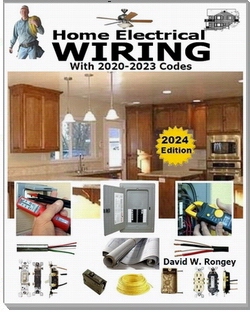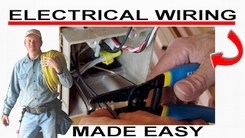» Need Electrical Help? Ask the Electrician
Questionable Electrical Wiring
 |
By Dave Rongey
Summary: Electrical Wiring Question: Hi i I had hired a electrician to run under cabinet lighting in my kitchen however for another problem not relating to that i had another electrical contractor through the house today and the holes are not patched from your install and he stated some alarming potential hazards with the install that i wanted to clear up. © By: Dave Rongey |
Questionable electrical wiring
Electrical Troubleshooting Question:
I hired a electrician to run under cabinet lighting in my kitchen however for another problem not relating to that i had another electrical contractor through the house today and the holes are not patched from your install and he stated some alarming potential hazards with the install that i wanted to clear up.
Basically I was told that the manner the lights have been installed was not up to NEC code.
I was told these several points
1. You cannot (by NEC code) use lamp cord inside walls.
2. you cannot hard-wire any lighting to the small appliance circuits above the counter. Is this true? or was this job up to code? ( i assumed it was since i hired a licensed electrician) i have since then contacted the electrical guy who installed the lights and he writes.
Please tell that contractor to verify the article :210.52B (1),(3) from the NEC code 2005.
As for the 1st point, I don't know what that contractor was talking about when he said that there's HAZARD danger.
The only possible problem is that if the cable (cord light) is fire-rated. I have asked a few electrical contractors about this situation and their opinions differ. Some said you can't use it and some said you can. I have searched in the books, but I have not found anything explaining what needs to be done.
For your safety reasons,we could solve this problem by either using a junction box under the cabinet and make all the lights under the cabinet (pull new jumpers).
The other option would be to change the under cabinet lighting, and pull hard wire between the lights.
My goal is customer satisfaction,if you pick the second option,I will pay for the old lights. Please let me know what you're planning to do and once again I'm sorry for this situation. I am now scared I cannot locate or understand any part of the NEC book and I am scared that my home will catch on fire with the current install job.
Can you assist in any way? Is what he did up to code? or not? and if it is not how do i go about fixing it and what part of the NEC did he violate with his install?
Thank you so much for taking your time to read this.
Thanks- Anita.
Hi Anita - Great Electrical Repair Question!
The best way for me to advise you would be to start with one Question: Was this electrical project installed through the authority of the local building department or jurisdiction, who issued a permit for the work?
If this is true then any possible faults or code violations will most likely be identified during the time of inspection by the building department representative.
If this is not the case then you may still contact your local building department and follow this recommended procedure, which will ensure that your electrical project has been performed safe, and will hold anyone responsible for any violations.
This will also provide important documentation which may be needed for correcting any problems. Let me know what happens.
The Safest Way to Test Electrical Devices and Identify Electric Wires!The Non-Contact Electrical TesterThis is a testing tool that I have had in my personal electrical tool pouch for years, and is the first test tool I grab to help identify electrical wiring. It is a Non-contact tester that I use to easily Detect Voltage in Cables, Cords, Circuit Breakers, Lighting Fixtures, Switches, Outlets and Wires. Simply insert the end of the tester into an outlet, lamp socket, or hold the end of the tester against the wire you wish to test. Very handy and easy to use.
The Quickest Way to Check for Faulty Electrical Wiring!The Plug-In Outlet TesterThis is the first tool I grab to troubleshoot a problem with outlet circuit wiring. This popular tester is also used by most inspectors to test for power and check the polarity of circuit wiring. It detects probable improper wiring conditions in standard 110-125 VAC outlets Provides 6 probable wiring conditions that are quick and easy to read for ultimate efficiency Lights indicate if wiring is correct and indicator light chart is included Tests standard 3-wire outlets UL Listed Light indicates if wiring is incorrect Very handy and easy to use.
Strip Off Wire Insulation without Nicking and Damaging the Electric Wire!The Wire Stripper and Wire CutterMy absolute favorite wire stripping tool that I have had in my personal electrical tool pouch for years, and this is the tool I use to safely strip electrical wires. This handy tool has multiple uses: The wire gauges are shown on the side of the tool so you know which slot to use for stripping insulation. The end of the tool can be used to grip and bend wire which is handy for attaching wire onto the screw terminals of switches and outlets.. The wire stripper will work on both solid and stranded wire. This tool is Very Handy and Easy to Use. |
||
Residential Electrical Parts and AccessoriesLight Switches 120volt Outlets Circuit Breakers Electrician Tools Voltage Testers |














